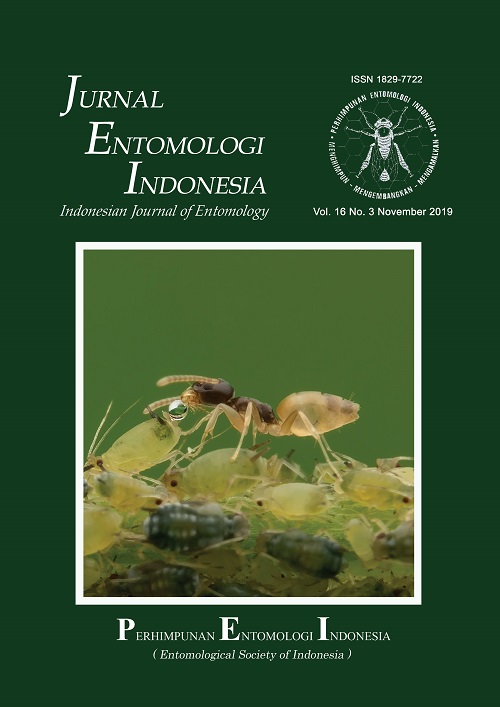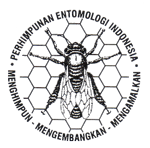Analisis kerusakan daun dan buah kelapa akibat serangan belalang Sexava
DOI:
https://doi.org/10.5994/jei.16.3.171Keywords:
coconut palm, mechanical damage, Sexava, TalaudAbstract
Sexava, the long-horned grasshopper, is an important pest of the coconut palm that destroys leaves and fruits. Study on analysis of damage to leaves and fruits of coconut palms due to being attacked by Sexava was aimed to determine the mechanism of the damage. Visual in situ observations were carried out in Salibabu Island, Talaud Islands Regency, North Sulawesi Province, while histological and chemical analyses of attacked young fruits and observation of symptoms of the secondary disease were carried out in the laboratory. The results showed that the process of damage to coconut-palm leaves and fruits due to bitten by the Sexava occurs mechanically. Phytotoxic symptoms due to bites of the long-horned grasshopper and symptoms of the secondary disease were not observed. Fruit tissue with a thickness of several millimeters appears to dry out and die while the tissue near the wound appears normal. Reduced sugar levels, cellulose, and lignin, between healthy fruit tissues (1.22%, 2.72%, 5.66%) and those attacked (1.22%, 2.85%, 4.84%) were relatively the same. The attacked young-fruits will fall out while attacked fruits on bunches more than 3 months old still keep to grow and develop until ripe.
Downloads
Downloads
Published
How to Cite
Issue
Section
License
Authors who publish with this journal agree to the following terms:
- Authors retain copyright and grant the journal right of first publication with the work simultaneously licensed under a Creative Commons Attribution 4.0 International License that allows others to share the work with an acknowledgement of the work's authorship and initial publication in this journal.
- Authors are able to enter into separate, additional contractual arrangements for the non-exclusive distribution of the journal's published version of the work (e.g., post it to an institutional repository or publish it in a book), with an acknowledgement of its initial publication in this journal.
- Authors are permitted and encouraged to post their work online (e.g., in institutional repositories or on their website) prior to and during the submission process, as it can lead to productive exchanges, as well as earlier and greater citation of published work (See The Effect of Open Access).








